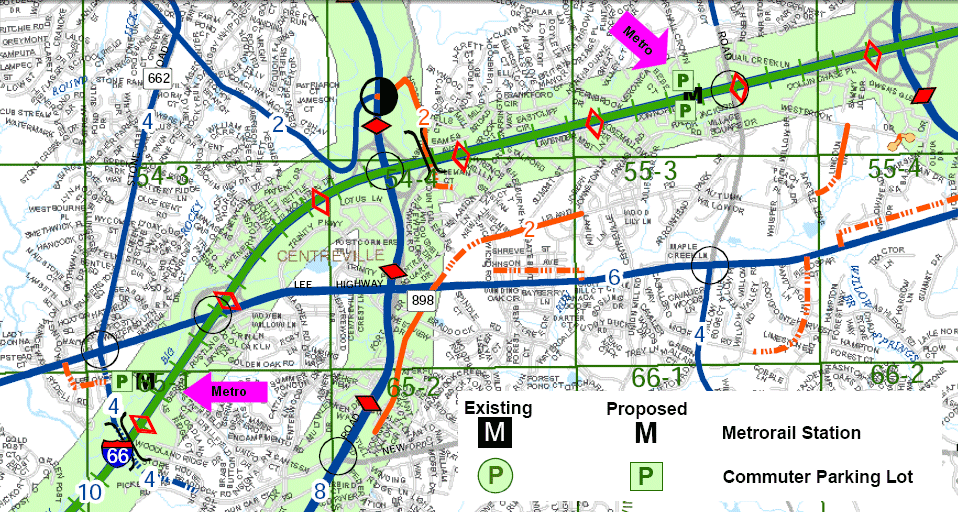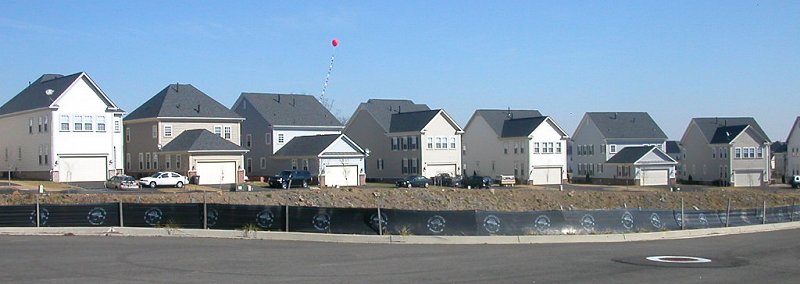
Metrorail stations near Centreville (proposed by Fairfax County)
(green line is I-66, while blue lines are proposals to expand roads)
Source: Fairfax CountyTransportation Map

Metrorail stations near Centreville (proposed by Fairfax County)
(green line is I-66, while blue lines are proposals to expand roads)
Source: Fairfax CountyTransportation Map
Fairfax has already identified where it wants to locate additional Metro stations near Centerville, including an end-of-the-line station at Stone Road and Route 29. One possibility is that the flat fields of Bull Run Regional Park, home of the annual Festival of Lights in December, could become a new railyard for storing trains overnight. The Washington Metropolitan Area Transit Authority (WMATA) has no official plans for such an extension, but long-range planning can be done by counties with a vision that takes awhile to catch on at the regional level.
Prince William County residents have dreamed of Metrorail as a solution to their transportation problems. In the 2007 election for chair of the Prince William Board of County Supervisors, both candidates supported extending Metro to the county. One candidate advertised:2
When the Commission on the Future presented its "Prince William County 2030" report in 2008, it projected the county would have Metrorail service on both the eastern end (with stops in Woodbridge and Quantico) and the western end (with stops in Manassas and Gainesville). The futurists even hypothesized a resident in 2030 saying:1
Prince William has never had any representatives on the board of Washington Metropolitan Area Transit Authority, The county has never funded Metrorail operations. That is in contrast to the Virginia Railroad Express (VRE). The county has representatives on the Virginia Railroad Express board and, in FY2024, budgeted nearl $5 million to support commuter rail operations.2
Prince William County talks about Metrorail in the very distant future, but has no specific plans for a route in the county. In the 2040 Comprehensive Plan, the Mobility Chapter included an aspirational Future Transit Alternatives Map that did sketch out a visionary extension of the Orange Line to Gainesville and a Blue/Yellow line xtension to Triangle. In other words, Prince William is an "outer" suburb (as in... "left out") when it comes to Metrorail, though the county is a key participant in VRE decisions.
Based on previous trends, the suburbs such as Prince William are expected to continue to grow in population. However, the jobs will remain concentrated in DC, inside the Beltway, and in the Tysons-to-Dulles corridor. That will require transporting commuters from suburban homes to urban-core job centers, and the options to expand commuter routes are very limited. Planners project massive traffic congestion even after adding extra High Occupancy Toll (HOT) lanes on I-95 and I-495, and perhaps a dedicated lane for Bus Rapid Transit (BRT) on I-66. The expected solution: shift commuters in Single Occupancy Vehicles (SOV's) to mass transit, especially high-speed "heavy rail" Metro.
The oither candidate, who ended up winning, commented three months later that the potential collapse of funding for the rail-to-Dulles project might create an opportunity for Prince William to get funding a Metrorail project.
Assuming the money was available for such a project... would it really benefit Prince William?

Today the majority of Prince William residents commute to another jurisdiction for work. Metrorail could certainly ease the commute, but traffic would be primarily into the urban core iun the morning rush hour and back to the periphery in the evening.
The other jurisdictions where Prince William residents work get the advantage of tax revenues from commercial office space. Those workers require few services during the day - commuters rarely go to the library, or use welfare services. In particular, commuters who live in Prince William but work in Fairfax do not. send their kids to Fairfax County schools. Fairfax gets the tax benefits from commercial property where Prince William residents work, plus sales tax revenues from business lunches near the office, while Prince William has to raise property taxes to build schools (and high schools now cost $100 million).
If Prince William focuses on creating smooth commuting paths to jobs in other jurisdictions... is that really a smart investment? Would it perpetuate the current condition, where Prince William is a bedroom community rather than an emplyment center? Should the counties on the periphery of the urban core invest in improving intra-county transportation (i.e., the Omni-Link service that runs just within Prince William) and not try to eliminate congestion for commuters?